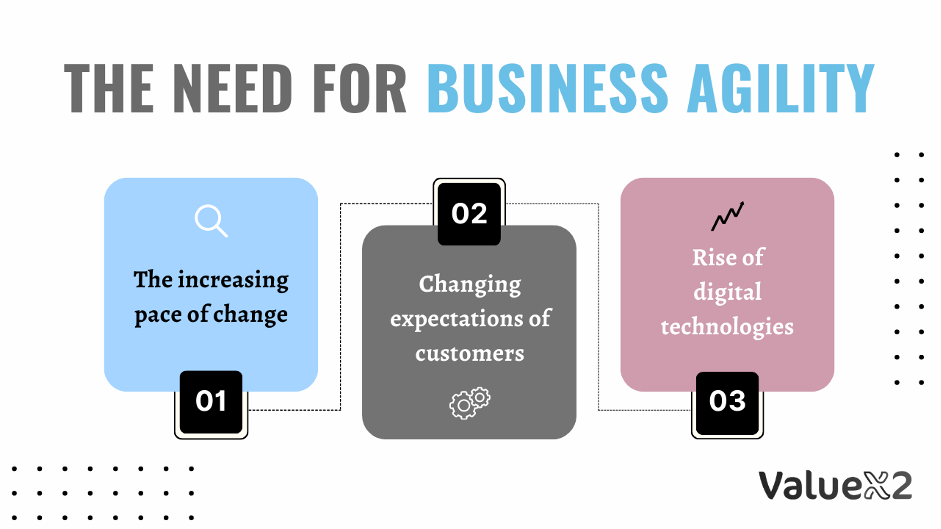Learn about the strategies for success in business agility and the benefits of business agility.

A key feature of business is its ability to change over time, remaining constant isn’t a good characteristic for your business. As the years have gone by, we have been able to witness the change of different organizations and how they have conquered the phase. Organizations need to have the ability to adapt quickly and be nimble to stay afloat.
Business agility helps make this come true as it is the ability of an organization to continuously adapt to change and innovation and deliver quality value to clients. This article focuses on the strategies for success in business agility and the benefits of business agility.
How to transition from Traditional to Agile
Having chosen the path of an Agilist, let us see how you can transform your company or yourself into one. To become an Agilist, you should first understand the Agile principles and values that guide Agile development. Learn about agile frameworks and use them to implement agile practices in your organization, there are certification courses in Scrum, Kanban, XP, and others.
Also, you can start small by implementing agile practices in a small team or project, get buy-ins from leadership, empower your team, and celebrate successes. Agile is a journey, not a destination, so be willing to learn, be adaptable, be resilient, and be patient.
The Need for Business Agility

As an organization, there may occur situations that push you towards change, in this case, agile transformation is the solution. Here are a couple of factors that encourage the need for business agility, below are some:
- The increasing pace of change: As most businesses have experienced, the business environment is quickly becoming complex and volatile. This has made it more difficult for organizations to predict the future outcomes.
- Changing expectations of customers: Customers are now very demanding. They are highly interested in personalized services and immediate services. The organization needs to be able to meet these client expectations for success. Keep your customers happy!
- Rise of digital technologies: The way business is carried out is changing daily, this is because of the rise in digital technology. Organizations need to adapt to this change and implement the urge for technological change to keep up and remain competitive.
Benefits of Business Agility
Having known the urge of a business to incorporate agility, we can now take a further venture into the world of business agility benefits:
-
Increased ability to adapt to change.
Agile organizations and businesses are well-equipped with ways of adapting to changes in the market space. Unlike traditional organizations, Agile businesses are able to stay ahead of the competition. All this is because, Agile companies can identify and respond to changes in the market, customer demands and technology before they escalate.
-
Improved innovation
Innovation can simply mean the practical implementation of ideas in order to come up with something new. Businesses that have adopted agile methodologies to their systems, find it easy to experiment with new ideas and learn from the mistakes that arise as a result. This is because they have a culture of risk-taking and experimenting.
-
Enhanced customer satisfaction
Agile organizations are better than traditional organizations, as they are better able to meet the needs of their clients, which leads to improved customer satisfaction. All this is because they gather intel and feedback from customers and iterate on their products and services accordingly.
-
Reduced costs
Agile organizations are usually more efficient, fast and accurate to produce quality valued products, this can reduce costs. They can reduce waste and bureaucracy during the development level of projects and products.
Strategies for Success
For an organization to improve on its road to business agility, there are many strategies to follow. These strategies give you hands-on information on how to successfully transition from traditional to agile.
1. Creating a culture of agility
This basically means creating an environment that is safe for employees to practice the art of risk-taking and experiments. This environment will make employees feel empowered.
2. Empowering teams
Agile organizations are made up of teams that are responsible for the success of their organization.
3. Using Agile frameworks
There are several agile frameworks that organizations can explore to attain business agility. These agile frameworks provide you with a set of principles and practices that will help in the success of business agility in an organization.
4. Measuring the track progress
It is important for organizations to measure and track their progress to ensure that they are on track to achieve their goals.
Conclusion
Businesses that want to flourish in the quickly shifting business environment of today must be agile in their operations. Organizations can increase their business agility and set themselves up for success in the future by using the ideas described in this article.

Bhavna is an Agile Coach and Consultant with over a decade of experience in advisory, corporate finance, IT assurance, and operations at Big 4 and within the industry in the UK and India. She has recently been the CEO of a start-up where she implemented agile practices within HR, Marketing, and Product teams.
She is also a SAFe® Practice Consultant (SPC) and authorized instructor for ICAgile Agility in HR (ICP-AHR), Agility in Marketing (ICP-MKG), and Business Agility Foundations (ICP – BAF) training courses. She provides training for agile transformation to corporate, public, and private batches, as well as consulting for enterprise agile transformation.






